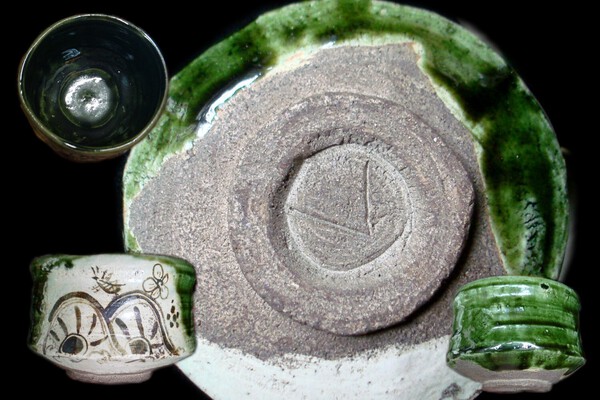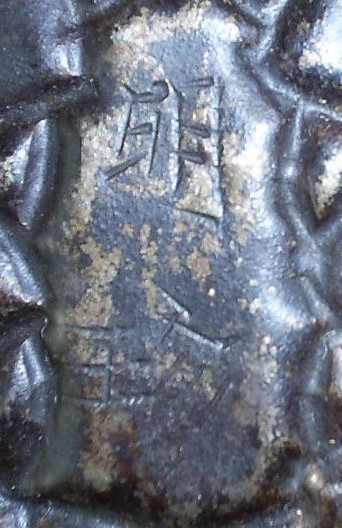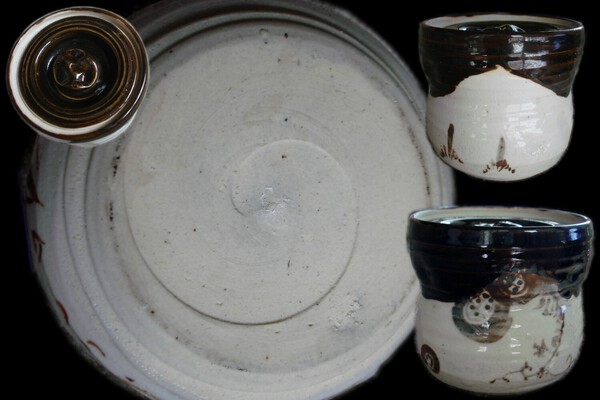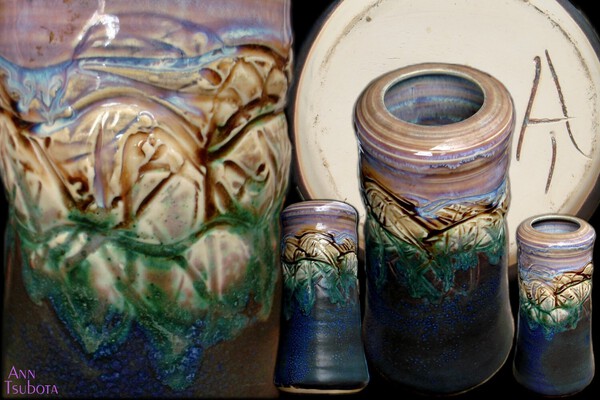-
Posts
317 -
Joined
-
Last visited
-
Days Won
8
Everything posted by ken kata
-
Read more
The information in the CHUO EXPRESS Excavation page was about Jomon Period items.
I was hoping I could find more information/websites about any newer excavations that might be the bowls the seller has.
I don't have enough/any Japanese knowledge on key words or phrases to use for the internet searches for newer Mino Bowl excavations.
The ending part of the seller's bowl descriptions had this :
" All four pieces I had TL-tested (Cost about $ 400 per piece) have confirmed an age about 400 yrs =/- 20%. "
I think he explained they were random from the batch of bowls he had..
This is from one of many TL Testing websites on the internet:
Accuracy of TL testing / dating
Generally speaking, when a sample is drilled and there is no information available about the burial environment, one may expect +/- 25% uncertainty, and this is more than adequate for authentication where the question is whether the piece was fired in antiquity or recently. The latest computer technology supports and completes analysis.Link :
-
Read more
Japanese Tea Bowl - MINO
Note: This is not a rant or complaint about the seller of these
" excavated" tea bowls " .
I am explaining the several intriguing/fascinating explanations that accompany the selling
of his/her tea bowls.
I do have several more tea bowls bought form the seller.
I will post them later in this series of postings about my experience.
So, first off, I want to establish the seller's beautifully stated, some what romanticized descriptions of each tea bowl.
I love his (or, who ever stated that ) description of each tea bowl.
It somehow, establishes the seller has knowledge of Mino tea bowls.
Secondly, Here is a statement that accompanies the description from the sellers postings :
" Mino ceramics were produced for the Kyoto market.
About 1630/40, a change of fashion took place, resulting in an overproduction at the kilns.
The merchandize was still warehoused at the kilns, but the Kyoto whole sellers did not buy anymore.
This is also evidenced by a number of full warehouses excavated in Kyoto.
Over the years the kilns were covered by leaves and humus.
Before the Tokyo Olympics an new highway was built trough the region (the Chuo Expressway), during the construction unknown kilns were unearthed but not scientifically recorded, because of time pressure.
On the construction free weekends people (mostly farmers living nearby) went 'treasure hunting' and found truck loads of tea bowls mizusashi and other tea ceramics.
Since about 1990 , these pieces appear in the market in Japan, as young people have little interest in tea ceremony or collecting anymore.
Of course there are broken pieces, but many are unharmed and were well protected by the soft earth of the woods; after rinsing the them with water, they look like new ? even though many have discoloration from black soil at the unglazed areas.
So, the first part, the seller, who has "knowledge" of Mino tea bowls, has a explanation of how he acquired these 400 year old Mino tea bowls , the CHUO EXPERSSWAY EXCAVATION.
I was searching the internet for information on the CHUO EXPRESSWAY EXCAVATIONS.
There was only one article I found, but, it was during the 70's and 80's. Not in the 1990's.
It also seems, that there were older ceramic pieces found. no mention of Edo period ceramics, unless, there was another "Excavation" later?
Here is a part of the CHUO EXPRESSWAY article :
" It may sound odd to have a museum accessible from an expressway rest area, but there is a story behind it.
During the construction of the Chuo Expressway in the late 1970s/early 1980s, planners realized the expressway would run through the Shakado area (named for a local temple) known to contain historical ruins.
When the road builders started digging the road bed, the ruins were found to be quite extensive, with layers of important artifacts dating from 1,000 years ago to 20,000 years ago.
It was decided to halt the road construction while the entire area was thoroughly excavated.
To complete the excavation as quickly as possible, an army of diggers–more than 20,000 people–were employed, including professional archaeologists, local farmers and their families, university students, and anyone willing to help out.
The dig lasted from February 1980 to November 1981.
Only after the excavation was completed was the expressway construction continued. "
Here is the link:
https://jigsaw-Japan.com/2019/02/16/shakado-museum-of-jomon-culture-really-digging-back-in-time/
-
Read more
Japanese TEA BOWL - MINO
Another tea bowl I bought from the seller that has 400 year old "Oribe" style/type tea bowls.
Note : Again, I do not think these bowls are 400 years old.
I bought them because I like them.
This is not a rant about the seller.
It is more of the interesting accounts that occurred
during the time I was buying these Mino tea bowls.
The seller's description :
Kuro-Oribe Chawan of Early Edo Period
" Slightly distorted cylinder shaped (hanzutsu) tea bowl with a rounded brim, made of light, coarse, unrefined Mino clay.The expertly thrown body was trimmed with a potter's knife in its lower part and around the foot ring.
In the style of Seto -Kuro bowls the this bowl was covered with a glossy, light brown glaze.
On one side a window was left unglazed and decorated with plants and grass in iron oxide under a clear ash glaze.
The low foot ring and the bowl's cylindrical shape resembles a Seto-Kuro bowl.
Next to the foot ring is an incised potters mark (kamajirushi) in form of a T.
This mark is commonly affiliated with the Kyoto trader Shimbei and was frequently found on early 17th century (arround1620) pots of the Entogawa-kiln in Mino.
The bowl is well balanced. "Next Post: The Chuo Express Excavations "
-
Read more
Japanese TEA BOWL - MINO
NOTE: This is one of my most intriguing encounter with buying Japanese Ceramics.
I am not mad at the seller, and, neither is this a "Rant" against him/her. I did like the Tea Bowls, and, I know/understand that it is the buyer's responsibility to know what he/she is buying.
In 2021. "It's nobody's fault but my own " is a fact of life.

I bought this Tea Bowl and this is the description from the seller :
Ao-Oribe Chawan of Early Edo Period
" Only little distorted cylinder shaped (hansutsu) tea bowl with a rounded brim, made of light, coarse, unrefined Mino clay.
The expertly thrown body was trimmed with a potter's knife in its lower part and around the foot ring.
This bowl was covered with a green copper oxide glaze.
On one side a window left unglazed and covered with a thin transparent ash glaze under which two wheels of law, two plum bosoms and a Cricket (korogi) were painted in iron oxide.
Inside the foot ring is a kiln mark (kamajirushi) in the shape of a V, a mark frequently found on shards excavated at the Entogawa-kiln in Mino, active during the first quarter of the 17th century.
The bowl is well balanced. "True (?), or just advertising , I did like the design and was willing to pay/bid on the Tea Bowl.
The two ( half wheels ) Cartwheels partially submerged in water/stream, was called " Katawa-guruma " ( Wheels in Stream ? )
The "V" in the foot ( Kodai ), might be a Merchant's mark.
From the book, " SHINO AND ORIBE CERAMICS " by Ryoichi Fujioka :
" Until the Meiji Period, these signs were considered to be the production marks of either the potter or the Kiln, and, in fact this long remained the popular view. "
Remember the Shimbei "T" ?
This is another interesting topic to be discussed later..
-
Read more
Just posting a "Gallery Presentation" of one of my Tea Bowls.
I make my own "Gallery Presentations" using PHOTO IMPACT PRO,
I still use the 8.1 version, because I only do simple Photo editing and
presentation/collages..
I usually take my own photos of my items, but, if the seller's photos was large and focused, I would use those. My camera is old. 8.1 Mega pixels..

-
Read more
Japanese Tea Bowl - Kitaoji Rosanjin
A few years ago, there were many Ao Oribe style Rosanjin Tea bowls on e-bay.
The prices were "Too good to be true"
I did buy two ( one from Fujiyama Gallery and the Crab tea bowl from Chanoyu ) .
I think both sellers names were Kentaro ?
Tomobako / Hakogaki was to be someone's authentication.
Gimei ?


I still like the bowls, so, I did not mind paying what they asked.
" Buy the Chawan, not the mei "

There are other " Oribe" style Tea Bowls that were bought from e-bay that were or had "Too good to be true" descriptions.
I will post about those soon..
-
Read more
Jizai Okimono - Ise Ebi
My 3 Spiney Lobsters displayed in my " Tea Bowl " room.
The first large lobster ( Orangish colored lobster on the left ) with Tomobako, is made by Muniyuki Myochin ( 51 st.) .
Dark colored iron Lobster by.. ( ? ) Close-up photo of the maker's name )
And, the 3rd lobster on the metallic gray coral is most popular/ common Lobster by " Hiromi ".....
I see the name Keijiro Kuwahara Hiromi in the description of some of these Lobsters.
The other lobsters and Crabs in the photo are solid, metal and not
" Adjustable ".
-
Read more
JIZAI OKIMONO - ( Articulated/Adjustable Display Item )
Shugyosha ( John J. ) posted an upcoming Auction..
Had this Jizai Okimono Silver Hermit Crab.
On Yahoo,
there is a Silver Ise Ebi ( Spiny Lobster) for only $1500.00
What a time to not have thousands id disposable income to spend..
I want then both .. LOL

-
Read more
SAMURAI MOVIES - KOJIRO ( 1967 )
This is one of the better dual sequences of all the Miyamoto Musashi duals in all the Mimamoto Musashi movies.
The dual between Miyamoto Musashi and Shishido Baiken.
In PART 2 , I had to re synchronize the audio, because the audio/sound was slightly "off" from the video.
You can see when Baiken's Kusarigama's weight hits the ground in the dual with Musashi..to Musashi and Shishido Baiken.
I divided the dual into two short videos...
PART 1
PART 2
Kikunosuke Onoe as Sasaki Kojiro and
Tatsuya Nakadai as Miyamoto Musashi..
There is no actors name who played Shishido Baiken, when I was looking at all the Kojiro 1967 reviews.
-
Read more
SUISEKI - The Art of Stone Appreciation
I bought this Japanese green stone on e-bay a few years ago, because the green on this rock seems like the glazes created on Ao Oribe Ceramics.
From WIKIPEDIA ( I am a Wikimedia supporting member
 )
)
" Green Oribe (青織部, Ao-Oribe), a ceramic with classical green glaze and underglaze painting. Green is the typical color of Oribe ware, along with white.[15] The original Chinese green was a smooth, even color like celadon.
Oribe, however, tried to use different shades of more natural green, in order to reflect green mountains or riverside scenes. The surface is painted and decorated with lively surface designs, which may be based on nature, geometric patterns, or a combination of the two. For the brilliant green color, wares are fired using oxidation at 1220 degrees Celsius. "
-
Read more
CERAMICS - ANN TSUBOTA
Professor Of Art
Raritan Valley Community College
New YORK
A couple of years ago, I was fortunate to be looking on e-bay, when this Ann Tsubota Iridescent Vase was listed.
I did not know who Ann Tsubota was, but, I did buy it.
After reading around, Ann seemed to be more into Raku-ware, and, " wabi-sabi ".
This vase seems to be the only one of her impression, or even abstract (?) pieces she ever made..
Sky, mountain, forest and water...
Thanks for viewing.
I see a photo of my vase still on Pinterest ...

-
Read more
TAMAHAGANE
I tried to update and lost that previous post on the Tamahagane I bought from "THE Japanese SWORD " website a few years ago.
The post came out on the top and I ended up deleting the post by accident.
About the Tomobako..
I was not sure of the translation.
I think it was
" The EASTERN Japan SWORD MAKERS ASSOCIATION ".
-
Read more
TAMAHAGANE - SUMIHIRA MANABE - sword maker
From the dvd /Video " ART OF THE Japanese SWORD "
Narrator :
Swordmaker Sumihira Manabe produces his own "Tamahagane" for his swords.
Manebe uses " Less refined iron sand brought down by remote mountain valleys."
Manabe :
" When I look at masterpiece swords of the Kamakura period, they have extremely interesting and good quality surface steel
When I saw this, I wanted to produce this kind of sword.
Then, I tried to figure out how to make that kind of sword.
In the end, I arrived at this kind of method.Using just pure iron sand doesn't produce good results.
Chikusa sand iron is good because it de oxidizes very efficiently, producing good quality iron.
It is not for making swords in the Bizen style tradition, but, it is good for making swords in the Soshu and Yamashiro traditions.
The different sand irons used results in subtle differences in the surface steel ( Jigane) of the completed sword. "
-
Read more
SAMURAI MOVIES - GANRYUJIMA
2003 release
Miyamoto Musashi vs. Kojiro Sasaki
A very different movie from the other Musashi / Sasaki Dual.
I found this movie/dvd entertaining, funny, and makes me wonder, too. LOL
I have read ( I don't remember where ) that this medical explanation ( Below ) was thought that may have happen......
" Traumatic brain injury (TBI) is frequently complicated by alterations in mood and behavior and changes in personality. We report mild personality changes post-TBI as a possible indicator of traumatic brain injury, but not of injury severity or psychiatric complications. "
- from the internet
-
Read more
Thoughts of a Sword Maker
Korehara Watanabe
" There are basically no directions or formulas left to make Koto from the Heian and Kamakura periods.
It is impossible to recreate the sword.
Many traditional craftsmen respond to modern times when handing down his craft.
But, the tradition suffers in doing so.
I think it is meaningless to carry on tradition this way "- KOREHARA WATANABE
Sword maker
DATE CITYHOKAIDO
From the Video :



























